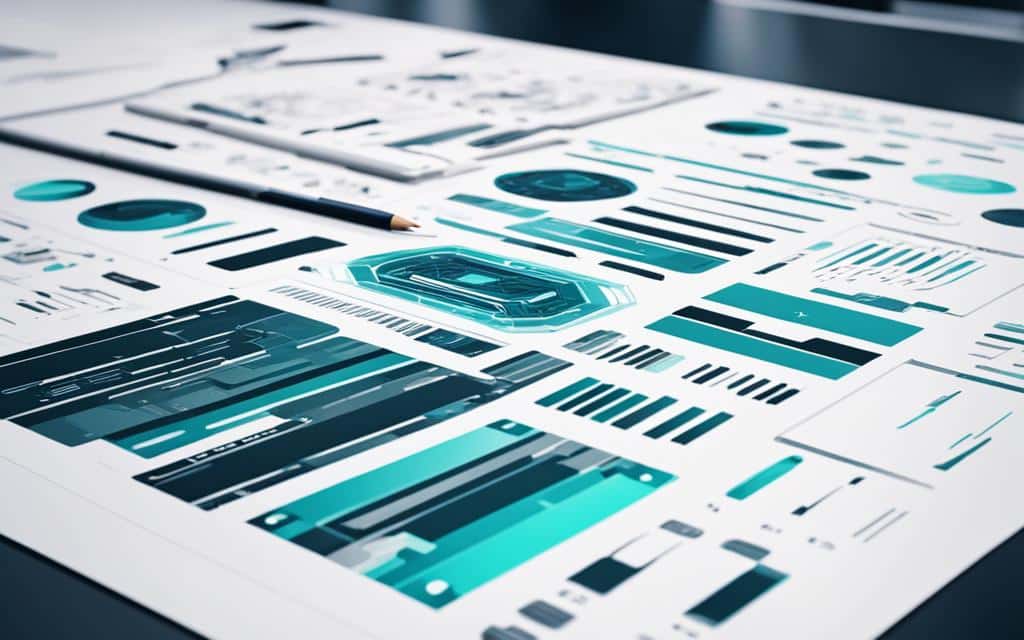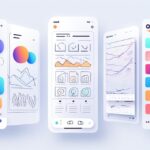Table of Contents
The design industry is constantly evolving, and with the rapid advancement of technology, the future of design tools looks promising. As we look ahead, it becomes clear that several emerging trends will shape the future of design.
Collaborative online work environments have become essential, leading to the rise of cloud-based software like Figma and Miro. These tools offer real-time collaboration features, enabling designers to work seamlessly together, regardless of their location.
Automation is also playing a significant role in design tools. Web-based formats are streamlining mediums beyond browsers and phones, making design processes more efficient and accessible. Markup languages like HTML and software such as Coda and Notion allow for dynamic presentations of structured data. Moreover, automation tools like Drawbot and Pagebot automate repetitive graphic tasks, improving efficiency in editorial design.
Another emerging trend in design tools is the use of node-based systems. These systems make programming more accessible for designers, enabling them to leverage softwares like Nuke, Houdini, and Cinema4D. Additionally, node-based systems enhance procedural thinking, allowing for non-destructive and flexible operations, ultimately reducing the need for layers.
Furthermore, designers no longer need extensive front-end development knowledge to create interactive websites. Tools like Squarespace, Wix, Sketch, and Figma empower designers to build interactive websites without heavy front-end development, simplifying the design process.
As the future unfolds, designers must stay updated with the latest tools and technologies to navigate the rapidly evolving design landscape successfully. Embracing innovation, prioritizing user experience, and fostering creativity will be key to creating effective designs that have a positive impact on the industry.
Stay tuned as we explore each of these emerging trends in detail and uncover the potential they hold for the future of design.
The Rise of Collaboration: Online tools for remote collaboration
The shift to remote work has increased the need for online collaborative tools in the design industry. Designers now rely on digital platforms to collaborate effectively, even when physically apart. These tools facilitate seamless communication, real-time collaboration, and efficient teamwork, enabling individuals to work together towards a common goal.
One popular tool for collaborative presentations is Google Slides. With its intuitive interface and comprehensive collaboration features, it allows multiple users to work on a presentation simultaneously, making remote meetings and client presentations more engaging and interactive.
“Remote collaboration has become an essential part of the design process. With the right tools, designers can work together regardless of their physical location, bringing diverse perspectives and expertise to the table.”
In addition to Google Slides, other online collaborative tools such as Figma, FramerX, Miro, and Mural have gained significant popularity in the design community. These software platforms offer real-time collaboration options, enabling designers to collaborate seamlessly on projects, share feedback, and iterate on designs in real-time.
Looking ahead, cloud-based software and multi-user collaborative features are expected to become even more prevalent. The future of design tools will revolve around creating an environment where remote teams can collaborate efficiently, breaking down geographical barriers and fostering creativity.
Benefits of online collaboration tools for remote teams
- Real-time collaboration: Designers can work together simultaneously, ensuring smooth workflow and eliminating the need for multiple email exchanges or delays caused by time zone differences.
- Efficient communication: Online collaborative tools provide chat and commenting features, facilitating quick and direct communication among team members.
- Version control and history tracking: These tools allow designers to track changes, access revision history, and revert to previous versions if necessary, ensuring a seamless design process.
- Secured cloud storage: Online collaborative tools offer cloud-based storage, reducing the risk of data loss and ensuring accessibility to files from anywhere with an internet connection.
As the design industry adapts to the remote work environment, the importance of online collaborative tools cannot be overstated. Designers must embrace these tools to enhance their productivity, foster effective teamwork, and deliver exceptional design outcomes.
Automation in Design: Streamlining processes with web-based formats
The ever-evolving design industry is experiencing a fundamental transformation with the introduction of web-based formats, which are revolutionizing the way design processes function. These formats leverage the power of markup languages such as HTML to efficiently organize information and enable dynamic presentations of structured data. Notable software like Coda and Notion empower designers to create engaging content that seamlessly adapts to varying requirements.
One remarkable development in design tools is the emergence of hybrid formatting for PDF, RTF, and HTML. These formats merge different mediums, allowing designers to work with greater fluidity and flexibility in their projects. By integrating multiple formats, designers can streamline their workflows, saving valuable time and effort.
An image can speak volumes about the benefits of automation in design:
Another key aspect of automation in design lies in the ability to automate repetitive graphic tasks. Tools like Drawbot and Pagebot provide designers with the means to automate processes such as book design, leading to improved efficiency and reduced workload. By eliminating manual and time-consuming tasks, designers can focus their creative energy on higher-level design decisions and deliver exceptional results.
In summary, automation in design and the utilization of web-based formats have transformed the design landscape. By harnessing the power of markup languages and leveraging innovative software, designers can streamline their processes, enhance productivity, and unlock new levels of creativity.
Accessibility and Procedural Thinking: Node-based systems for designers
Node-based systems are revolutionizing the design industry by making programming more accessible and intuitive for designers. These innovative systems, utilized in software such as Nuke, Houdini, and Cinema4D, employ node-based editors that simplify procedural operations. By replacing intricate lines of code with visual representations, designers can easily manipulate and control complex processes.
One example of the impact of node-based systems is educational programming software like Scratch. By presenting coding concepts visually, Scratch helps students grasp the fundamentals of coding and procedural thinking. This approach encourages a deeper understanding of programming logic while fostering creativity and problem-solving skills.
Procedural thinking, facilitated by node-based systems, allows designers to perform non-destructive and flexible operations. This eliminates the need for excessive layering and speeds up the design process. With node-based systems, designers can experiment freely, tweak designs effortlessly, and iterate more effectively.
“Node-based systems empower designers to think in a procedural manner, allowing for efficient and dynamic design processes.”
As the design industry continuously evolves, the adoption of node-based systems is expected to expand further. Design tools are anticipated to implement these intuitive systems, enhancing accessibility and enabling designers to create intricate designs with ease.
| Benefits of Node-based Systems for Designers | Examples of Software |
|---|---|
| Simplifies programming for designers | Nuke |
| Visual representation of complex processes | Houdini |
| Encourages procedural thinking | Cinema4D |
| Non-destructive and flexible operations | Scratch |
By embracing node-based systems, designers can unlock their creative potential and streamline their design workflows. With the continued development and implementation of innovative tools, the design industry is poised to achieve new heights of accessibility and efficiency.
Empowering Designers: Building interactive websites without heavy front-end development
Traditional web design often requires extensive knowledge of front-end development, posing challenges for designers seeking to create interactive websites. However, a new wave of design tools has emerged, empowering designers to build engaging web experiences without the need for advanced coding skills.
The Evolution of Design Tools
Gone are the days when designers solely relied on static design software. Today, a range of innovative design tools cater to the needs and skill sets of modern designers. Let’s explore some of the leading options.
- Squarespace: Squarespace is a popular website builder that offers creative professionals the flexibility to design and launch stunning websites. With its intuitive drag-and-drop interface, designers can easily incorporate interactive elements, such as galleries, forms, and animations.
- Wix: Wix provides a comprehensive suite of tools and features that enable designers to create dynamic websites without writing a single line of code. From responsive layouts to customizable designs, Wix empowers designers to bring their vision to life.
- Sketch: Sketch is a versatile design tool that focuses on user interface and user experience design. With its robust plugin ecosystem and artboard features, designers can prototype and build interactive websites with ease.
- Figma: Figma is a collaborative design tool that caters to teams of designers and developers. Its cloud-based platform allows for real-time collaboration and interactive prototyping, ensuring smooth workflows and seamless communication.
By leveraging these design tools, designers can unleash their creativity and build interactive websites that captivate users. The integration of drag-and-drop interfaces and visual design elements empowers designers to bring their visions to life, all without the need for extensive front-end development knowledge.
Streamlining Workflows
As designers’ roles evolve, so do their workflows. The traditional separation between designers and developers is gradually diminishing, with front-end developers transitioning into the roles of interaction engineers and animators.
“Designers and developers are no longer working in silos; they are collaborating closely to create compelling web experiences. The rise of design tools that bridge the gap between design and development is transforming the way we build interactive websites.”
This shift towards more streamlined workflows allows designers to take full ownership of their designs, resulting in greater efficiency and collaboration. With the latest design tools, designers can focus on the creative aspects of web design, while developers contribute their expertise to bring those designs to life.
Achieving Design Excellence
Building interactive websites without heavy front-end development is not only empowering for designers but also crucial for delivering exceptional user experiences. With the right design tools at their disposal, designers can create engaging websites that seamlessly blend aesthetics and functionality.
When designers can focus on the visual aspects of their designs, they can iterate more quickly, experiment with different ideas, and refine their creations based on user feedback. This iterative design process ensures that websites are not only visually appealing but also intuitive and user-friendly.
| Benefits of Building Interactive Websites without Heavy Front-end Development |
|---|
| 1. Accelerated design iteration |
| 2. Enhanced collaboration between designers and developers |
| 3. Increased efficiency in website creation |
| 4. Seamless integration of visual design and user experience |
| 5. Empowerment of designers to take ownership of their designs |
By embracing design tools that enable interactive website creation without heavy front-end development, designers can push the boundaries of their creativity and deliver exceptional web experiences that captivate and engage users.
Conclusion
The design industry is poised for a future brimming with exciting changes and growth. As trends like AI integration, accessibility, and voice user interfaces shape the landscape of digital design, designers must stay updated with the latest tools and technologies to thrive in this rapidly evolving field. Prioritizing user experience and embracing experimentation will be crucial for success.
By leveraging new technologies and fostering creativity, designers can create innovative and effective solutions that have a positive impact on the industry. The future of design holds promising opportunities for those who can adapt and harness the power of these advancements.
As the design industry continues to evolve, it is essential for designers to stay agile and open-minded. Embracing innovation and exploring new possibilities will ensure that designers remain at the forefront of the ever-changing design landscape. By continuously pushing the boundaries and seeking innovative design solutions, designers can shape the future of design and contribute to its ongoing growth and success.
FAQ
What are the emerging trends in future design tools?
The future of design tools is expected to bring exciting changes and growth to the design industry. Trends like AI integration, accessibility, and the use of voice user interfaces are set to shape digital design.
What are some online collaborative tools for remote collaboration in the design industry?
Google Slides, Figma, FramerX, Miro, and Mural are popular choices for designers looking for real-time collaboration options and efficient collaboration among remote teams.
How do web-based formats streamline design processes?
Web-based formats like HTML, Coda, and Notion allow for efficient organization of information and dynamic presentation of structured data. Hybrid formatting for PDF, RTF, and HTML is becoming common, merging different mediums and improving efficiency in editorial design.
What are node-based systems and how do they make programming more accessible for designers?
Node-based systems, used in softwares like Nuke, Houdini, and Cinema4D, employ visual editors for procedural operations. They make programming more accessible by allowing designers to understand coding visually and enabling non-destructive and flexible operations.
Can designers build interactive websites without extensive front-end development knowledge?
Yes, tools like Squarespace, Wix, Sketch, and Figma provide options for designers to efficiently create interactive websites, reducing the need for extensive front-end development knowledge. Designers and developers are transitioning into roles of interaction engineers and animators to streamline workflows.
How can designers stay equipped for success in the rapidly evolving world of design?
Designers should stay updated with the latest tools and technologies, prioritize user experience, and embrace experimentation. By leveraging new technologies and fostering creativity, designers can create innovative and effective designs that have a positive impact on the industry.







